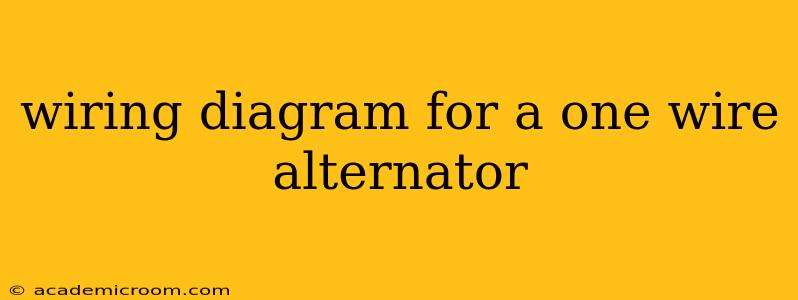The one-wire alternator, a marvel of automotive simplicity, offers a straightforward charging solution. Unlike its multi-wire counterparts, it requires minimal wiring, reducing complexity and potential points of failure. However, understanding its wiring diagram and functionality is crucial for proper installation and operation. This guide will delve into the specifics, answering common questions and providing a clear understanding of this system.
What is a One-Wire Alternator?
A one-wire alternator, as its name suggests, uses only one wire to connect to the battery. This single wire provides both the excitation signal and the path for the alternator's output current. This contrasts with multi-wire alternators, which often utilize separate wires for field excitation, sensing, and power output. The simplicity of the one-wire system makes it popular in older vehicles and some custom applications. The alternator's internal regulator manages the voltage output, eliminating the need for external components.
How Does a One-Wire Alternator Work?
The magic lies in the alternator's internal regulator. When the engine is running, the residual magnetism in the alternator's rotor generates a small voltage. This small voltage, passed through that single wire to the battery, is sufficient to excite the alternator's field winding. As the engine speed increases, so does the alternator's output voltage. The internal regulator monitors the voltage and adjusts the field current to maintain a stable output, typically around 13.5-14.5 volts. This self-regulating mechanism is the core of the one-wire system's effectiveness.
Typical Wiring Diagram for a One-Wire Alternator
The wiring diagram is remarkably simple:
[Battery Positive (+)] --- [Single Wire] --- [Alternator's "B+" Terminal]
That's it! The "B+" terminal on the alternator is where the single wire connects. This single wire carries both the excitation current and the charging current to the battery. The ground connection is typically made through the alternator's case and mounting bolts, directly to the engine block.
What Size Wire Should I Use for a One-Wire Alternator?
The wire gauge should be sufficient to handle the alternator's maximum output current. Using a wire that's too thin can lead to overheating and potential damage. Consult your alternator's specifications for its maximum amperage rating. A heavier gauge wire (lower number, like 8 or 10 AWG) is usually recommended for reliability and safety.
Can I Use a One-Wire Alternator in Any Vehicle?
While conceptually straightforward, compatibility matters. Simply bolting a one-wire alternator onto any vehicle might not work. You need to ensure that the alternator's amperage rating is sufficient for your vehicle's electrical needs. Improperly sized alternators can either undercharge or overcharge your battery, leading to premature failure. It's also essential to ensure the alternator's mounting and pulley specifications match your vehicle's existing setup.
What if My One-Wire Alternator Isn't Charging?
Troubleshooting a non-charging one-wire alternator requires systematic investigation. First, check the battery voltage. Then, check the single wire connection for any breaks or corrosion. Finally, inspect the alternator's output using a voltmeter to determine if it's generating any voltage at all. Internal regulator failure is a common cause of malfunction in one-wire alternators.
Does a One-Wire Alternator Need a Voltage Regulator?
No, a one-wire alternator has its voltage regulator built into the unit itself. This internal regulator handles the voltage regulation, making external regulators unnecessary. This is a key feature that simplifies installation and reduces complexity.
Are One-Wire Alternators Reliable?
One-wire alternators, when properly installed and sized, can be very reliable. Their simplicity contributes to this reliability; fewer components mean fewer potential failure points. However, like any automotive component, they can wear out over time, especially if subjected to harsh operating conditions. Regular maintenance, including checking the connections and belt tension, can prolong their lifespan.
This comprehensive guide provides a detailed explanation of one-wire alternators and their wiring. Remember to always consult your vehicle's specifications and the alternator's documentation before attempting any installation or repair. If you are uncertain about any aspect of the process, it's best to seek professional assistance.
